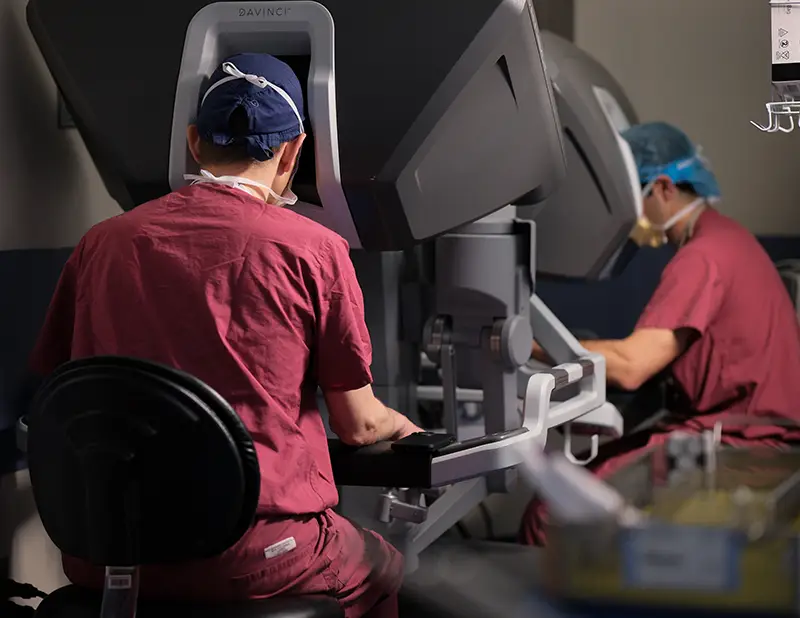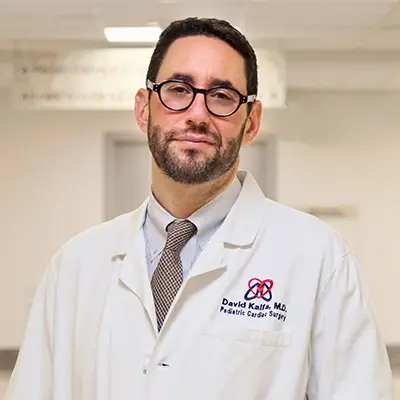Cardiac surgeons at NewYork-Presbyterian and Columbia have launched a new program offering robotic cardiac surgery to children as young as 6 years old. To date, the program has successfully performed robotic procedures to address atrial septal defects, partial anomalous pulmonary venous return, mitral valve conditions, and double aortic arch in children.
Led by Arnar Geirsson, MD, director of the Cardiovascular Institute and the Surgical Heart Value Program at NewYork-Presbyterian/
“The pediatric cardiac robotic program is a truly novel initiative that allows our young patients to avoid a sternotomy and to go home sooner after surgery with much less pain and discomfort,” says Dr. Bacha.
I think it can be a game changer for children born with congenital heart diseases.
— Dr. David Kalfa
NewYork-Presbyterian and Columbia is the first program in the U.S. dedicated to performing robotic cardiac procedures on children, utilizing a dedicated pediatric surgical team to routinely performing robotic surgeries.
“I think it can be a game changer for children born with congenital heart diseases,” Dr. Kalfa says.
Benefits of Robotic Surgery
Robotic surgery is appropriate for a range of conditions affecting children, including atrial septal defects, partial anomalous pulmonary venous return, and Scimitar syndrome. Mitral valve repair and tricuspid valve repair, which are common adult procedures involving the surgical robot, can also be performed safely on children.
Robotic cardiac surgery offers several benefits. It is generally less invasive, leads to less bleeding and surgical complications, and has a decreased length of hospitalization. But for pediatric patients in particular, the ability to undergo cardiac surgery with minimal scaring is significant.
“We know that in pediatrics, the psychological impact of a sternotomy is significant,” Dr. Kalfa says. “There have been some studies showing that, especially in girls, seeing a sternotomy scar every single day for the rest of your life has a significant impact on your emotional wellbeing.”
There are also potential benefits in reducing pain. Other minimally invasive approaches to open heart surgery involve a vertical incision that can be more painful than open approaches like sternotomy. But using the surgical robot, surgeons can perform the procedure without opening the space between the ribs, reducing postoperative pain for patients.
I think this will be offered more and more, especially for kids who are appropriate candidate for it so they can avoid sternotomy.
— Dr. Arnar Geirsson
Patient selection is critical when considering robotics and patients are evaluated with chest X-ray and CT scan to measure the amount of space available within the chest and with ultrasound to measure the size of heart vessels. “If a patient is a good candidate, it’s a no-brainer that the robotic approach would be the technique that is favored since it is much less invasive than other approaches,” Dr. Kalfa says.
Building on Robotic Cardiac Surgery Program
The pediatric program is the latest offering from the Robotic Cardiac Surgery Program at NewYork-Presbyterian and Columbia, which began in September 2023. That program, which was launched under the direction of Dr. Geirsson, recently hit a significant milestone – performing more than 100 robotic cardiac procedures in the first year.
For adults, a robotic surgical system is used to provide minimally invasive cardiac surgery and reconstructive valve surgery with a shorter hospital length of stay and a quicker return to daily activities.

The surgical robot has two surgical consoles, allowing the surgeons and trainee to work side-by-side.
The pediatric program will follow the same blueprint for success, utilizing a dedicated team of specially trained operating room nurses, along with a pediatric perfusion team, and a pediatric anesthesiology team.
Traditionally, technology and a lack of training have limited the number of surgeons performing robotic cardiac surgery in children, Dr. Kalfa said, but the new focus on robotics at NewYork-Presbyterian and Columbia aims to change that trend.
Dr. Geirsson says he anticipates that advances in tools and techniques will also allow the team to take on even more advanced cases over time. Manufacturers are already finetuning surgical robots so that the arms can be modified for the small size of pediatric patients and redesigning aortic clamps to better function for children.
“I think this will be offered more and more, especially for kids who are appropriate candidate for it so they can avoid sternotomy,” Dr. Geirsson says.




